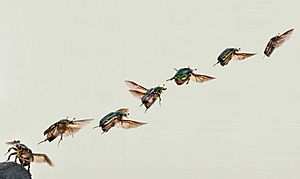Movement facts for kids

Movement, also called motion, is when something changes its position. This means it changes where it is. Think of a bird flying or a person walking. They are moving because they go from one place to another. Many parts of science and math help us understand movement.
Scientists like Galileo Galilei and Albert Einstein taught us that position and movement are relative. This means they depend on other things around them. For example, a ball might be 5 feet from a box. It could be 3 feet from a chair and 1 foot from a table. Its position is how far it is from these other things. Movement is also relative. It depends on where something is and where it's going compared to other things.
Many things are involved in how things move. These include speed, velocity, acceleration, and gravity. Other forces like magnetic attraction and repulsion, friction, and inertia also play a part. To make something move, you also need to do work. Did you know that Light moves super fast? It travels about 300,000 kilometres (or 186,000 miles) every second!
How Animals Move
Animals move thanks to their nervous system. This amazing system includes the brain and spinal cord. It controls all the ways an animal can move its body.
Your brain has special areas that help you move. For example, the primary motor cortex in your brain sends signals directly to your spinal cord. This helps you make very exact and controlled movements. Other important brain parts like the premotor cortex, basal ganglia, and cerebellum also help. They make sure your movements are smooth, timed right, and well-planned.
- The spinal cord contains special motor neurons. These neurons send messages directly to your muscles, telling them to move.
- Your Cerebellum helps you move with precision and good timing. It makes sure your movements are coordinated.
- The Basal ganglia helps you choose which actions to take. It's like deciding if you want to run or walk.
- The Motor cortex in your brain sends direct signals to your spinal cord. This allows for voluntary movements.
- The Premotor cortex helps group simple movements into bigger, more coordinated patterns.
- The Supplementary motor area helps you put movements in order. For example, when you tie your shoes, it helps you do the steps in the right sequence.
- The Prefrontal cortex helps with planning. It's involved in thinking about your movements before you do them.
Your nervous system also controls things you don't even think about. This is called the autonomic nervous system. It manages things like your heart rate, digestion, and how fast you breathe. It also controls salivation (making spit) and perspiration (sweating). Most of these functions happen automatically, without you trying to control them.
Related pages

